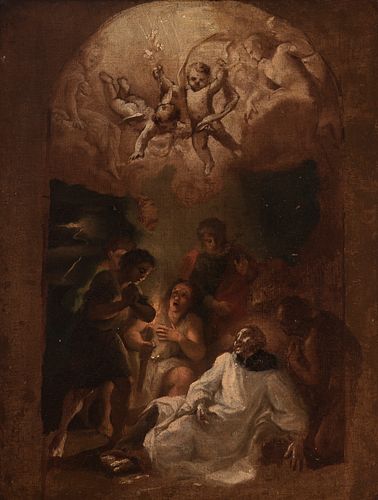Circle of ANTON RAPHAEL MENGS (Aussig, Ústi nad Labem, Czech Republic, 1728-Rome, 1779) "Transit of Saint Dominic". Oil on canvas.
Lot 38
About Seller
Setdart Auction House
Carrer Aragó 346
Barcelona
Spain
Setdart Subastas was born in 2004 and is currently the first online art auction in Spain with solidity, prestige and reliability guaranteed by our more than 60,000 users. Setdart has a young, dynamic and enterprising team ready to successfully manage the purchase and sale of art works through custom...Read more
Estimate:
EUR€2,500 - EUR€3,000
$2,688.17 - $3,225.81
Absentee vs Live bid
Two ways to bid:
- Leave a max absentee bid and the platform will bid on your behalf up to your maximum bid during the live auction.
- Bid live during the auction and your bids will be submitted real-time to the auctioneer.
Bid Increments
| Price | Bid Increment |
|---|---|
| EUR€0 | EUR€10 |
| EUR€200 | EUR€25 |
| EUR€500 | EUR€50 |
| EUR€1,000 | EUR€100 |
| EUR€3,000 | EUR€200 |
| EUR€5,000 | EUR€500 |
| EUR€10,000 | EUR€1,000 |
| EUR€20,000 | EUR€2,000 |
| EUR€50,000 | EUR€5,000 |
About Auction
By Setdart Auction House
Nov 3, 2021
Set Reminder
2021-11-03 08:00:00
2021-11-03 08:00:00
America/New_York
Bidsquare
Bidsquare : OLD MASTERS
https://www.bidsquare.com/auctions/setdart-auction-house/old-masters-7786
Setdart Auction House sofia@setdart.com
Setdart Auction House sofia@setdart.com
- Lot Description
Circle of ANTON RAPHAEL MENGS (Aussig, Ústi nad Labem, Czech Republic, 1728-Rome, 1779) "Transit of Saint Dominic". Oil on canvas. Preserves original canvas and has signature on the back. It has slight faults, repainting and frame of the nineteenth century with flaws in the carving. Measurements: 60 x 46 cm; 74 x 59 cm (frame). It is probable that this work was conceived by the author as a sketch, or a study of a larger piece. This assumption arises from the sketchy technique used by the author, the small dimensions and the composition of the work, which presents the scene in a reduced area of the total surface of the area. This painted area, which is delimited on the canvas, is exceeded in some cases by the shapes of the figures, thus showing the author's interest in sticking to a specific space and adapting the figures to it as much as possible. Painter and theorist of neoclassicism, Anton Raphael Mengs was trained both in the practical aspect of painting and in the theory of art, under the influence of Winckelmann, of whom he was a friend and prominent student. He trained in Dresden under the direction of his father, Ismael Mengs, a court painter. Later, between 7141 and 1744, he traveled to Rome to further his education with Marco Benefial, studying especially ancient sculpture and the painting of Raphael and the classicists of the seventeenth century. In 1744 he returned to Dresden and was appointed court painter, where he devoted himself mainly to portraits. In 1746 he was appointed painter to King Augustus III of Poland, and subsequently undertook a journey through Italy, ending in Rome, where he settled permanently. In the Italian capital he painted important religious and mythological works in fresco, showing a mature style of a clearly neoclassical character, influenced by the Renaissance and, more specifically, by the work of Raphael. In 1761 he was called to Spain, where he remained until 1769 as the first painter of King Carlos III. For him he painted works destined to decorate the Royal and Aranjuez palaces, and also painted important portraits. His presence in Madrid definitely pushed Tiepolo into a corner, since Mengs represented a new taste that was well accepted by the court. Although he would later return to Rome, he would visit the Spanish court again between 1774 and 1776, shortly before contracting the illness that would lead him to die in Italy in 1779. Works by Mengs are currently preserved in the Prado Museum, the Louvre in Paris, the Hermitage in St. Petersburg, the Metropolitan in New York, the National Gallery and the Royal Collection in London, the Art Institute of Chicago, the Albertina in Vienna and other leading art galleries in Europe and the United States.
- Shipping Info
-
In-house shipping available. Please inquire at admin@setdart.com.
-
- Buyer's Premium



 EUR
EUR CAD
CAD AUD
AUD GBP
GBP MXN
MXN HKD
HKD CNY
CNY MYR
MYR SEK
SEK SGD
SGD CHF
CHF THB
THB

















